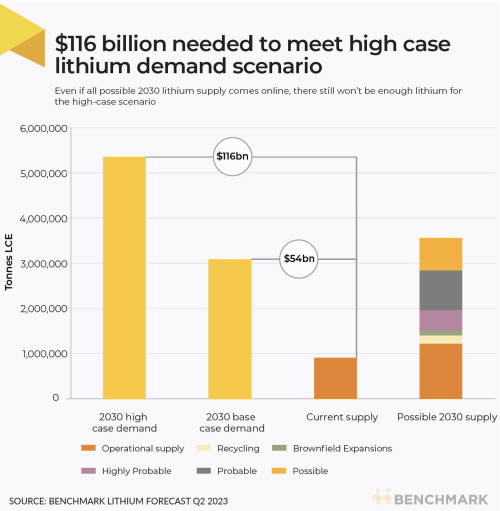Energy & Critical Metals
Benchmark: Lithium industry needs more than $116B to meet automaker and policy targets by 2030
The lithium industry needs to invest $116 billion by 2030 if the world is to meet the ambitions targets set by governments and the largest automakers,…

The lithium industry needs to invest $116 billion by 2030 if the world is to meet the ambitions targets set by governments and the largest automakers, according to a Benchmark analysis. This is more than double the $54-billion investment needed to meet Benchmark’s base case lithium demand scenario. This is an updated calculation following the investment analysis Benchmark developed last quarter.
This “high case” scenario is based on automakers hitting their targets and electric vehicle penetration increasing on the back of enacted decarbonization policies from governments around the world. A major driver behind the high case demand scenario are optimistic automaker targets.
-
General Motors and Mercedes-Benz aim to produce only electric vehicles by 2035 and 2030, respectively.
-
Stellantis aims for 100% of its Chinese vehicles to be electric by 2030. The company is also targeting 50% of all its vehicles in the US and 100% of all its passenger vehicles in Europe to be electric by 2030.
-
Tesla is targeting production of 20 million passenger EVs by 2030. In 2022, the company produced just over 1.3 million EVs.
Benchmark’s high case scenario forecasts that 7.0 TWh of batteries will be needed in 2030, compared to 3.9 TWh in the base case scenario.
Benchmark’s high case scenario, which encompasses data from Rho Motion on automakers’ passenger EV targets as well as data from the International Energy Agency on enacted country-level policies, would require 5.3 million tonnes of lithium carbonate equivalent (LCE). This is compared to the 915,000 tonnes LCE production in operation today.
But without large increases in the amount of lithium, these targets will be impossible to hit. With the amount of lithium production forecast by Benchmark for 2030, only 3.2 TWh of lithium ion batteries can be produced, highlighting that the mineral is a constraining factor.
The money needs to go into building new mines and refineries, as well as into expanding existing assets. Even if every asset in the pipeline came online on time and hit their projected lithium production capacities, the world would still need 1.8 million tonnes on top of that to meet the high case demand.
It’s almost impossible, and definitely a race against time. The big money that needs to be spent takes time to get approval for and to deploy. The players with skin in the game are the least likely to rush their spending. They don’t want to flood the market with lithium too quickly. They want to release it slowly to maximize their return.
As a carmaker, consumer, or EV policy maker, should I be alarmed? Yes.
—Cameron Perks, an analyst at Benchmark
Automakers are increasingly cutting out the middlemen and looking to secure lithium directly. Another major driver for the increased demand of the high-case scenario compared to the base case is primarily driven by ambitious governmental policies that aim to reduce the carbon emissions of the transport sector.
The US is targeting a 50% penetration rate of EVs (battery, plug-in hybrid, and fuel cell) in new sales by 2030. The UK will ban the sale of new internal combustion engine vehicles in the same year, with hybrids allowed until 2035. The EU has an ICE ban from 2035.
Globally, Benchmark’s Lithium ion Battery Database forecasts that 43.7% of new vehicle sales will be electric by 2030. This drastically increases to 82.5% if OEM targets and current policy targets are met. As a result, demand for lithium-ion batteries jumps in 2030 from 3.9 TWh in the base case to 6.1 TWh in the high case.
This analysis is drawn from the detail in Benchmark’s Lithium Forecast service – which provides detailed analysis and forecasts for supply, demand, prices and costs out to 2040.

Uranium Exploration Company Announces Additional Staking in the Athabasca Basin
Source: Streetwise Reports 12/22/2023
Skyharbour Resources Ltd. announced an update from its Canada-based Falcon Project along with additional…
Tesla Launches New Mega Factory Project In Shanghai, Designed To Manufacture 10,000 Megapacks Per Year
Tesla Launches New Mega Factory Project In Shanghai, Designed To Manufacture 10,000 Megapacks Per Year
Tesla has launched a new mega factory…
Giving thanks and taking stock after “a remarkable year”
An end-of-year thank you to our readers, industry colleagues and advertisers before Electric Autonomy breaks from publishing until Jan. 2
The post Giving…











